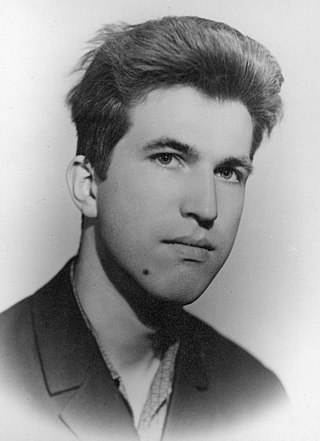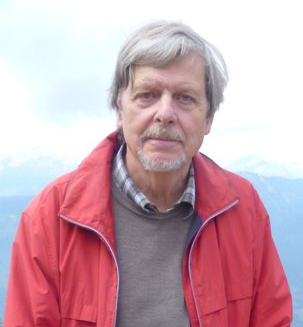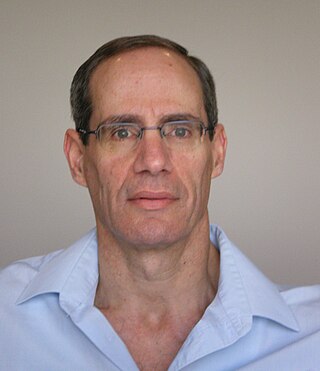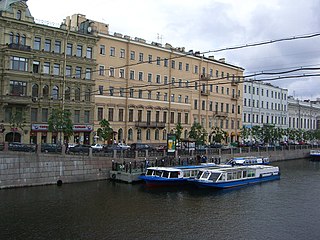Combinatorics is a branch of mathematics concerning the study of finite or countable discrete structures.

Yuri Vladimirovich Matiyasevich, is a Russian mathematician and computer scientist. He is best known for his negative solution of Hilbert's tenth problem, which was presented in his doctoral thesis at LOMI.
Aleksandr Aleksandrovich Razborov, sometimes known as Sasha Razborov, is a Soviet and Russian mathematician and computational theorist. He is Andrew McLeish Distinguished Service Professor at the University of Chicago.

Detlev Buchholz is a German theoretical physicist. He investigates quantum field theory, especially in the axiomatic framework of algebraic quantum field theory.

Ludvig Dmitrievich Faddeev was a Soviet and Russian mathematical physicist. He is known for the discovery of the Faddeev equations in the theory of the quantum mechanical three-body problem and for the development of path integral methods in the quantization of non-abelian gauge field theories, including the introduction of Faddeev–Popov ghosts. He led the Leningrad School, in which he along with many of his students developed the quantum inverse scattering method for studying quantum integrable systems in one space and one time dimension. This work led to the invention of quantum groups by Drinfeld and Jimbo.

Noga Alon is an Israeli mathematician and a professor of mathematics at Princeton University noted for his contributions to combinatorics and theoretical computer science, having authored hundreds of papers.

Oleg Yanovich Viro is a Russian mathematician in the fields of topology and algebraic geometry, most notably real algebraic geometry, tropical geometry and knot theory.

The St. Petersburg Department of Steklov Institute of Mathematics of the Russian Academy of Sciences is a mathematical research institute in St. Petersburg, part of the Russian Academy of Sciences. Until 1992 it was known as Leningrad Department of Steklov Institute of Mathematics of the USSR Academy of Sciences.
Rostislav Ivanovich Grigorchuk is a mathematician working in different areas of mathematics including group theory, dynamical systems, geometry and computer science. He holds the rank of Distinguished Professor in the Mathematics Department of Texas A&M University. Grigorchuk is particularly well known for having constructed, in a 1984 paper, the first example of a finitely generated group of intermediate growth, thus answering an important problem posed by John Milnor in 1968. This group is now known as the Grigorchuk group and it is one of the important objects studied in geometric group theory, particularly in the study of branch groups, automaton groups and iterated monodromy groups. Grigorchuk is one of the pioneers of asymptotic group theory as well as of the theory of dynamically defined groups. He introduced the notion of branch groups and developed the foundations of the related theory. Grigorchuk, together with his collaborators and students, initiated the theory of groups generated by finite Mealy type automata, interpreted them as groups of fractal type, developed the theory of groups acting on rooted trees, and found numerous applications of these groups in various fields of mathematics including functional analysis, topology, spectral graph theory, dynamical systems and ergodic theory.

Rodney Graham Downey is a New Zealand and Australian mathematician and computer scientist, an emeritus professor in the School of Mathematics and Statistics at Victoria University of Wellington in New Zealand. He is known for his work in mathematical logic and computational complexity theory, and in particular for founding the field of parameterised complexity together with Michael Fellows.
Leon Armenovich Takhtajan is a Russian mathematical physicist of Armenian descent, currently a professor of mathematics at the Stony Brook University, Stony Brook, NY, and a leading researcher at the Euler International Mathematical Institute, Saint Petersburg, Russia.
Vera Faddeeva was a Soviet mathematician. Faddeeva published some of the earliest work in the field of numerical linear algebra. Her 1950 work, Computational methods of linear algebra was widely acclaimed and she won a USSR State Prize for it. Between 1962 and 1975, she wrote many research papers with her husband, Dmitry Konstantinovich Faddeev. She is remembered as an important Russian mathematician, specializing in linear algebra, who worked in the 20th century.

Aleksei Nikolaevich Parshin was a Russian mathematician, specializing in arithmetic geometry. He is most well-known for his role in the proof of the Mordell conjecture.

Anatol Slissenko is a Soviet, Russian and French mathematician and computer scientist. Among his research interests one finds automatic theorem proving, recursive analysis, computational complexity, algorithmics, graph grammars, verification, computer algebra, entropy and probabilistic models related to computer science.
Boris Lvovich Feigin is a Russian mathematician. His research has spanned representation theory, mathematical physics, algebraic geometry, Lie groups and Lie algebras, conformal field theory, homological and homotopical algebra.
Nikolai Georgievich Makarov is a Russian mathematician. He is known for his work in complex analysis and its applications to dynamical systems, probability theory and mathematical physics. He is currently the Richard Merkin Distinguished Professor of Mathematics at Caltech, where he has been teaching since 1991.

Sergei Alekseevich Evdokimov was a Russian mathematician who contributed to the theory of modular forms, computational complexity theory, algebraic combinatorics and p-adic analysis.

Joris van der Hoeven is a Dutch mathematician and computer scientist, specializing in algebraic analysis and computer algebra. He is the primary developer of GNU TeXmacs.

Elena Yanovskaya is a Soviet and Russian mathematician and economist known for her contributions to cooperative game theory.












